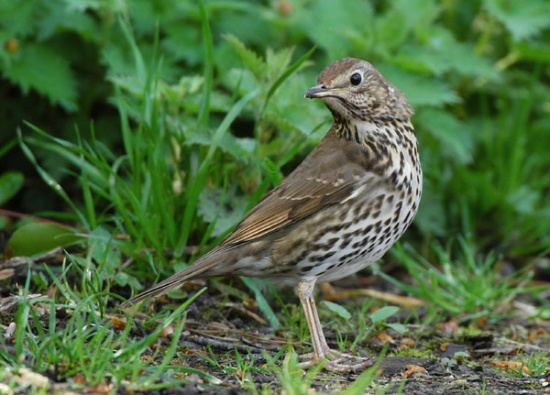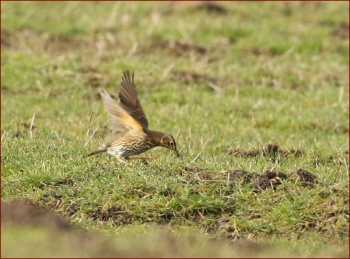(Flight photo replaced with underwing shot) |
Nutcracker (talk | contribs) (more details) |
||
| Line 2: | Line 2: | ||
;[[:Category:Turdus|Turdus]] philomelos | ;[[:Category:Turdus|Turdus]] philomelos | ||
==Identification== | ==Identification== | ||
| − | + | Length 20–23 cm, weight 50-107 g<br /> | |
| − | *Plain brown back | + | '''Adult''': sexes similar |
| − | * | + | *Plain brown back and wings, except for small buff tips to greater and median coverts |
| − | * | + | *Underparts buffish with numerous dark brown triangular or slightly arrow-shaped spots |
| − | + | *Underwing close to body orange-buff<br /> | |
| + | '''Juvenile''': | ||
| + | *As adult but lightly streaked / spotted above, with larger buff tips to greater and median coverts | ||
====Similar Species==== | ====Similar Species==== | ||
[[Image:A forman 389.jpg|thumb|350px|right|Photo by {{user|spock|spock}}<br />[[Norfolk]], February 2010]] | [[Image:A forman 389.jpg|thumb|350px|right|Photo by {{user|spock|spock}}<br />[[Norfolk]], February 2010]] | ||
| − | [[Mistle Thrush]] has greyer upperparts and the spots are round. Female [[Eurasian Blackbird]]s is larger and much darker brown. | + | [[Mistle Thrush]] is obviously larger, has greyer upperparts and the spots are round. Female [[Eurasian Blackbird]]s is slightly larger and much darker brown. [[Redwing]] is similar size, and has prominent white supercilium, and red underwing. [[Chinese Thrush]] is very similar, differing only in slightly more prominent vertical bars on face and larger breast spots, but does not overlap in range. |
==Distribution== | ==Distribution== | ||
| − | + | Breeds throughout [[Europe]] south of about 70°N, but only at high altitudes in the [[Mediterranean]] region; also western [[Asia]] east to Lake Baikal in central [[Siberia]], and the [[Caucasus]] and [[Alborz]] mountains of [[Iran]] in southwest Asia. | |
| − | + | Most of the birds winter further south and southwest (south to northern [[Africa]]), though populations in western and southern Europe are partly resident. In [[Britain]], most of the breeding population (''T. p. clarkei'') leaves for the coldest parts of winter for [[France]] and [[Spain]], but some (around 20%, mainly males) remain through the winter, with the rest returning in February-March; many nominate ''T. p. philomelos'' (often distinguishable by their slightly greyer plumage) also arrive in autumn from [[Scandinavia]] in late September to early October, some remaining to winter, others moving on to France and beyond. | |
| − | + | A vagrant in [[Iceland]] (annual), [[Svalbard]], the [[Azores]], [[Madeira]], and [[Mauritania]]. | |
| + | |||
| + | The species has been introduced to [[New Zealand]], where it is common and widespread, and [[Australia]], where a small population survives around Melbourne. | ||
==Taxonomy== | ==Taxonomy== | ||
| − | ====Subspecies<sup>[[#References|[1]]]</sup> | + | Most closely related to the [[Chinese Thrush]] of central China. |
| − | + | ====Subspecies==== | |
| + | There are 4 subspecies<sup>[[#References|[1]]]</sup>: | ||
*''T. p. hebridensis'': | *''T. p. hebridensis'': | ||
| − | :*[[Outer Hebrides]] and [[Isle of Skye]] | + | :*[[Outer Hebrides]] and [[Isle of Skye]]; resident, or wintering in [[Ireland]]. Slightly darker than ''T. p. clarkei''. |
*''T. p. clarkei'': | *''T. p. clarkei'': | ||
| − | :*[[British Isles]] and western [[Europe]]; winters to northern Mediterranean basin | + | :*[[British Isles]] and western [[Europe]]; winters to northern Mediterranean basin. Slightly warmer brown than ''T. p. philomelos''. |
*''T. p. philomelos'': | *''T. p. philomelos'': | ||
| − | :*Northern and eastern [[Europe]] to central [[Asia]]; winters to | + | :*Northern and eastern [[Europe]] to central [[Asia]]; winters to north [[Africa]] and [[Iran]]. |
*''T. p. nataliae'': | *''T. p. nataliae'': | ||
| − | :*Sayan Mountains to Lake Baikal and northern [[Iran]]; winters to southern [[Iran]] | + | :*Sayan Mountains to Lake Baikal and northern [[Iran]]; winters to southern [[Iran]]. Marginally paler than ''T. p. philomelos''. |
==Habitat== | ==Habitat== | ||
| − | Woods, hedges, gardens | + | Woods, hedges, gardens. Unlike [[Mistle Thrush]] tends to avoid wide open spaces, though wintering birds are common in sand dune systems with little more than marram grass cover. |
==Behaviour== | ==Behaviour== | ||
They do not form flocks, although several birds may be seen together where there is suitable habitat, especially in the winter. They often appear to be rather tame. | They do not form flocks, although several birds may be seen together where there is suitable habitat, especially in the winter. They often appear to be rather tame. | ||
Revision as of 15:08, 7 December 2014

- Turdus philomelos
Identification
Length 20–23 cm, weight 50-107 g
Adult: sexes similar
- Plain brown back and wings, except for small buff tips to greater and median coverts
- Underparts buffish with numerous dark brown triangular or slightly arrow-shaped spots
- Underwing close to body orange-buff
Juvenile:
- As adult but lightly streaked / spotted above, with larger buff tips to greater and median coverts
Similar Species
Mistle Thrush is obviously larger, has greyer upperparts and the spots are round. Female Eurasian Blackbirds is slightly larger and much darker brown. Redwing is similar size, and has prominent white supercilium, and red underwing. Chinese Thrush is very similar, differing only in slightly more prominent vertical bars on face and larger breast spots, but does not overlap in range.
Distribution
Breeds throughout Europe south of about 70°N, but only at high altitudes in the Mediterranean region; also western Asia east to Lake Baikal in central Siberia, and the Caucasus and Alborz mountains of Iran in southwest Asia.
Most of the birds winter further south and southwest (south to northern Africa), though populations in western and southern Europe are partly resident. In Britain, most of the breeding population (T. p. clarkei) leaves for the coldest parts of winter for France and Spain, but some (around 20%, mainly males) remain through the winter, with the rest returning in February-March; many nominate T. p. philomelos (often distinguishable by their slightly greyer plumage) also arrive in autumn from Scandinavia in late September to early October, some remaining to winter, others moving on to France and beyond.
A vagrant in Iceland (annual), Svalbard, the Azores, Madeira, and Mauritania.
The species has been introduced to New Zealand, where it is common and widespread, and Australia, where a small population survives around Melbourne.
Taxonomy
Most closely related to the Chinese Thrush of central China.
Subspecies
There are 4 subspecies[1]:
- T. p. hebridensis:
- Outer Hebrides and Isle of Skye; resident, or wintering in Ireland. Slightly darker than T. p. clarkei.
- T. p. clarkei:
- British Isles and western Europe; winters to northern Mediterranean basin. Slightly warmer brown than T. p. philomelos.
- T. p. philomelos:
- T. p. nataliae:
Habitat
Woods, hedges, gardens. Unlike Mistle Thrush tends to avoid wide open spaces, though wintering birds are common in sand dune systems with little more than marram grass cover.
Behaviour
They do not form flocks, although several birds may be seen together where there is suitable habitat, especially in the winter. They often appear to be rather tame.
Breeding
The twiggy nest is lined with moss or grass. The clutch consists of 3 to 5 blue eggs with dark spots. They are incubated for 14-15 days, fledging after a further 2 weeks. There may be 3 broods in the season which lasts from March to July.
Diet
The diet consists of snails, insects, worms, fruit and berries. To eat the snails, they find a suitable stone which is used as an "anvil" to smash the shell.
Vocalisation
Song: very loud, consisting of short phrases repeated 2-4 times.
<flashmp3>Turdus philomelos (song).mp3</flashmp3>
Listen in an external program
References
- Clements, JF. 2009. The Clements Checklist of Birds of the World. 6th ed., with updates to December 2009. Ithaca: Cornell Univ. Press. ISBN 978-0801445019.
- Animal Corner
- Bird Watching
- BF Member observations
Recommended Citation
- BirdForum Opus contributors. (2024) Song Thrush. In: BirdForum, the forum for wild birds and birding. Retrieved 29 April 2024 from https://www.birdforum.net/opus/Song_Thrush
External Links




